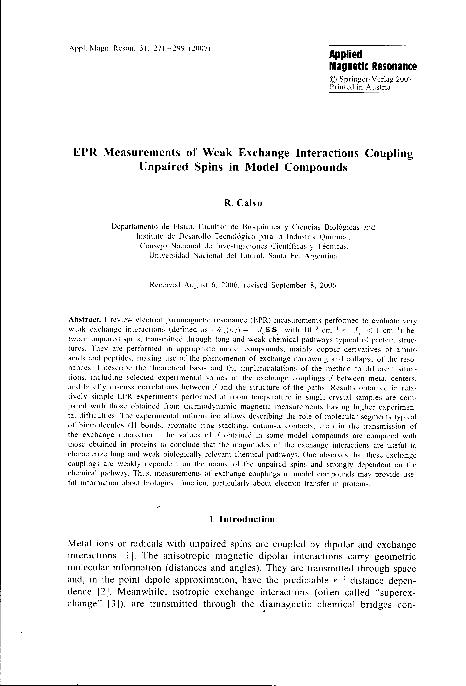Mostrar el registro sencillo del ítem
dc.contributor.author
Calvo, Rafael

dc.date.available
2017-07-17T21:26:54Z
dc.date.issued
2007-12
dc.identifier.citation
Calvo, Rafael; EPR Measurements of Weak Exchange Interactions Coupling Unpaired Spins in Model Compounds; Springer; Applied Magnetic Resonance; 31; 12-2007; 271-299
dc.identifier.issn
0937-9347
dc.identifier.uri
http://hdl.handle.net/11336/20771
dc.description.abstract
I review electron paramagnetic resonance (EPR) measurements performed to evaluate very weak exchange interactions (defined as Hex(i, j) = -JijSiSj, with 10-3 cm-1<|Jij|<1 cm-1) between unpaired spins, transmitted through long and weak chemical pathways typical of protein structures. They are performed in appropriate model compounds, mainly copper derivatives of amino acids and peptides, making use of the phenomenon of exchange narrowing and collapse of the resonances. I describe the theoretical basis and the implementations of the method to different situations, including selected experimental values of the exchange couplingsJ between metal centers, and briefly discuss correlations betweenJ and the structure of the paths. Results obtained in relatively simple EPR experiments performed at room temperature in single-crystal samples are compared with those obtained from thermodynamic magnetic measurements having higher experimental difficulties. The experimental information allows describing the role of molecular segments typical of biomolecules (H bonds, aromatic ring stacking, cation-p contacts, etc.) in the transmission of the exchange interaction. The values ofJ obtained in some model compounds are compared with those obtained in proteins to conclude that the magnitudes of the exchange interactions are useful to characterize long and weak biologically relevant chemical pathways. One observes that these exchange couplings are weakly dependent on the nature of the unpaired spins and strongly dependent on the chemical pathway. Thus, measurements of exchange couplings in model compounds may provide useful information about biological function, particularly about electron transfer in proteins.
dc.format
application/pdf
dc.language.iso
eng
dc.publisher
Springer

dc.rights
info:eu-repo/semantics/openAccess
dc.rights.uri
https://creativecommons.org/licenses/by-nc-sa/2.5/ar/
dc.subject.classification
Física de los Materiales Condensados

dc.subject.classification
Ciencias Físicas

dc.subject.classification
CIENCIAS NATURALES Y EXACTAS

dc.title
EPR Measurements of Weak Exchange Interactions Coupling Unpaired Spins in Model Compounds
dc.type
info:eu-repo/semantics/article
dc.type
info:ar-repo/semantics/artículo
dc.type
info:eu-repo/semantics/publishedVersion
dc.date.updated
2017-07-13T18:46:32Z
dc.journal.volume
31
dc.journal.pagination
271-299
dc.journal.pais
Austria

dc.journal.ciudad
Viena
dc.description.fil
Fil: Calvo, Rafael. Consejo Nacional de Investigaciones Científicas y Técnicas. Centro Científico Tecnológico Conicet - Santa Fe. Instituto de Desarrollo Tecnológico para la Industria Química. Universidad Nacional del Litoral. Instituto de Desarrollo Tecnológico para la Industria Química; Argentina
dc.journal.title
Applied Magnetic Resonance

dc.relation.alternativeid
info:eu-repo/semantics/altIdentifier/doi/http://dx.doi.org/10.1007/BF03166261
dc.relation.alternativeid
info:eu-repo/semantics/altIdentifier/url/https://link.springer.com/article/10.1007%2FBF03166261
Archivos asociados
